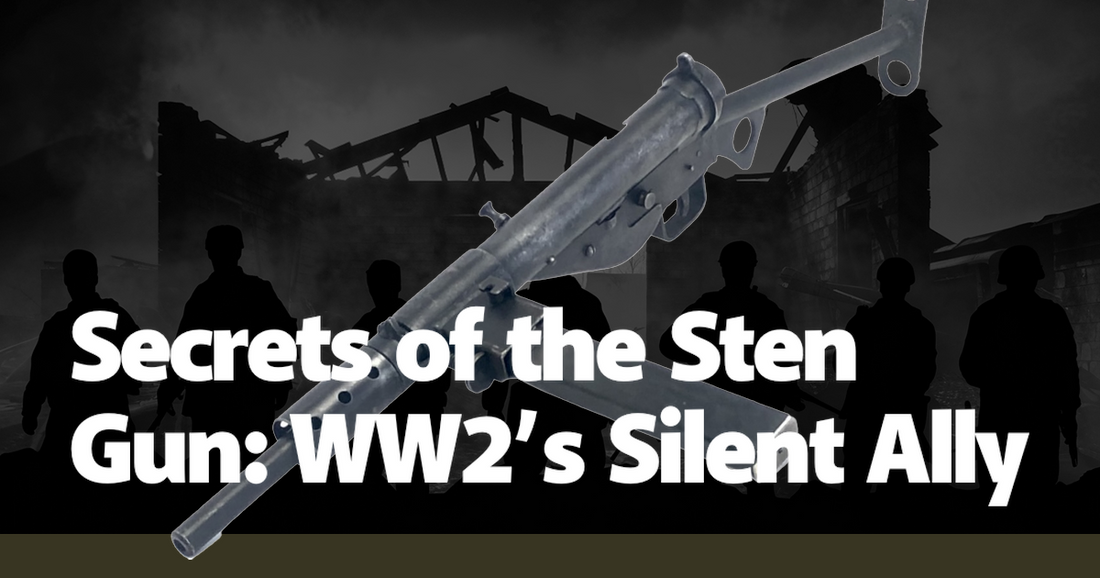In the shadowy theaters of World War II, where the clamor of battle often drowned out the subtleties of strategy, the Sten gun emerged as a silent yet formidable ally. This unassuming submachine gun, with its rudimentary design and stark functionality, became a symbol of resilience and ingenuity. Born out of necessity, the Sten gun's creation was a direct response to the dire need for an affordable, mass-producible weapon that could be swiftly deployed to the front lines. Its story is one of innovation under pressure, where simplicity proved to be its greatest strength.
The Sten gun, named after its creators Major Reginald V. Shepherd and Harold Turpin, along with the Enfield factory where it was manufactured, was a marvel of minimalist engineering. Unlike the finely crafted firearms of the era, the Sten gun's design was stripped down to the essentials. Comprised of just 47 parts, it could be assembled quickly and with minimal machining. This was a critical advantage during the war, as traditional weapon manufacturing processes were slow and resource-intensive. The Sten's utilitarian design allowed for rapid production, with some models being assembled in as little as five hours.
One of the most compelling aspects of the Sten gun was its role in the hands of resistance fighters across occupied Europe. Its ease of use and the ability to be produced clandestinely made it a favorite among partisan groups. In the dense forests of Eastern Europe and the urban labyrinths of France, the Sten gun became a symbol of defiance. Resistance fighters, from the Free French Forces to the Polish Home Army, relied on the Sten to carry out sabotage missions, ambushes, and assassinations. Its compact size and low recoil made it ideal for close-quarters combat, where quick, decisive action was paramount.
The Sten gun's impact was not limited to the resistance movements. It also played a crucial role in the British military strategy. During the early years of the war, Britain faced a severe shortage of firearms. The fall of France and the evacuation of Dunkirk had left the British Army in dire straits, with much of their equipment abandoned on the beaches. The Sten gun, with its low production cost and ease of manufacture, was the perfect solution to this crisis. By 1941, the Sten was being produced in vast quantities, providing British troops with a reliable weapon that could be quickly distributed and used effectively in various combat scenarios.
Despite its many advantages, the Sten gun was not without its flaws. Its simplistic design, while beneficial for production, also led to reliability issues. The open-bolt mechanism and crude construction made it prone to jamming and accidental discharge. These shortcomings were particularly evident in the early Mk I and Mk II models. However, the British military quickly addressed these issues, leading to improvements in later versions. The Mk III and Mk V models, for example, featured enhanced reliability and better ergonomics, making them more effective in the field.
Anecdotes from soldiers who used the Sten gun paint a vivid picture of its versatility and impact. One such story comes from the Battle of Arnhem, where British paratroopers, armed with Sten guns, held off German forces for days despite being heavily outnumbered. The Sten's rapid rate of fire and ease of handling allowed the paratroopers to lay down suppressive fire, buying precious time for their comrades. Another account from the Italian campaign describes how a single Sten gun, wielded by a resourceful soldier, was used to capture an entire German patrol by surprise, highlighting the weapon's potential for psychological as well as physical impact.
The legacy of the Sten gun extends beyond its wartime service. In the years following World War II, the Sten continued to see action in various conflicts around the world. Its design principles influenced the development of future submachine guns, and its role in the war became a subject of study for military historians and enthusiasts. The Sten gun's story is a testament to the power of innovation in the face of adversity. It serves as a reminder that sometimes, the simplest solutions can have the most profound impact.
In conclusion, the Sten gun stands as a silent witness to the ingenuity and resilience of those who fought in World War II. Its unassuming appearance belies the significant role it played in the conflict. From the resistance fighters in occupied Europe to the soldiers on the front lines, the Sten gun was a reliable companion in the darkest of times. Its legacy is one of simplicity, efficiency, and the relentless pursuit of victory. As we reflect on the secrets of the Sten gun, we are reminded of the countless untold stories of courage and innovation that shaped the course of history.

